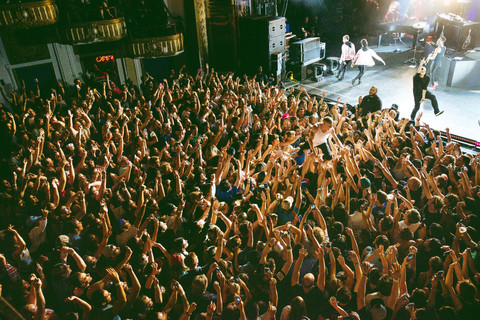[Majestic Journal] When Older Is (Sometimes) Better
- Joshua Coase

- Aug 30, 2018
- 5 min read
A deeper look into why some music photographers are deliberately opting out of newer tech.

Music photographers pride themselves on being able to capture the emotions and iconic scenes from the most intimate concerts to huge world-renowned festivals. With a rapidly evolving camera scene, from smartphones to the latest mirrorless cameras and state of the art DSLRs to drones, we live in a world where capturing that moment has never been easier.

"I think we are at a place where you don’t need much to take an amazing photo,” says Zoe Rain, who toured the globe with Macklemore and Ryan Lewis and has contributed to the likes of The Grammys, Rolling Stone, and The New York Times. The 25-year-old Seattleite still uses the same reliable camera she’s had for four years.
With all the advancements in digital technology that have happened since then, one would think that a portrait photographer, at the cutting edge of her profession, would want to try her hand with the latest cameras and equipment – but not Rain.
"When you focus on the next new model and don’t get comfortable with one solid setup, you can really just be mediocre at what you do,” explains Rain. "I could always wonder if I had a faster camera, what action shots I would have been able to capture at rapid fire that I didn’t get on my Nikon D810. However, I don’t really like to think like that though, because if I do, I would go crazy with the what if’s.”
For Rain, the equipment available to her at any given time has never affected the job at hand. "I’ve used an iPhone for a Rolling Stone assignment at the Grammys when my large DSLR wasn’t permitted in the building,” recalls Rain.
"When you focus on the next new model and don’t get comfortable with one solid setup, you can really just be mediocre at what you do." - Zoe Rain

Mel D. Cole has never been one to care about the specifications or technical capabilities behind the lens either, especially not early in his career. Cole first discovered that he had an eye for shooting while using disposable cameras, before making a hefty $400 purchase of a Fujifilm Finepix S5100 to make the most out of his talent.
"Back in the day I was all about capturing moments,” says Cole. "But as I grew, I figured out that I needed to step my camera gear game up because I couldn't do the things I wanted and thought that I could do with a 4-megapixel camera.”
Now shooting images of Kanye West and Childish Gambino with his Canon Mark III, Cole is not planning on upgrading any time soon.
"When I find a product that I love, I will stick with it until it does not work anymore,” says Cole. "I live and play within my pay grade, not above, until above is not enough.”

Brandon Artis, an events photographer from Vancouver, currently uses two full frame bodies, the Nikon D850 and D750, the latter of which he has owned for three years. Despite the introduction of a new Nikon body at the beginning of this year, the D750 remains his primary camera for concerts and festivals.
"The only other thing I’m looking to pick up soon is a 35mm 1.4 lens,” says Artis. "My go to for portraits has always been a 50mm 1.4.”

While he has all the digital tools he needs, Artis does have a love and appreciation for shooting using more traditional methods.
"I do often buy random old point-and-shoot film cameras whenever I come across them at thrift stores,” says Artis. "I much prefer the unpredictable outcome of an old camera, to the guaranteed outcome of new technology.”
Marshmello (left) and Kanye West (right) photographed by Brandon Artis
Technology is advancing rapidly, to the point where photographers now have the ability to capture crowd shots and their interactions with artists from a whole new perspective without holding a camera. For example, drones are a common sight at major music festivals – but are the photographs they capture worthy of being featured in magazine spreads?
Artis believes they are a positive addition to enhance events coverage, even though he has no desire to take up using one as a hobby himself.
"I think they're definitely handy at music events for getting large scale shots that show the extent of the crowd and production,” says Artis. "The only time I find them intrusive is when someone doesn't know what they're doing and ends up flying them too low to the crowd, or hovering in certain areas for too long.”
"I much prefer the unpredictable outcome of an old camera, to the guaranteed outcome of new technology." - Brandon Artis
Rain, however, struggles to see the benefits they provide other than a few hero shots, echoing a widespread concern about the safety surrounding their use.
"Tons of venues have some pretty high spots to shoot from that give very similar aspects of a crowd, without being a distraction or safety hazard,” she says.

Cole is also less enthusiastic about what drones bring to the table for music photography, viewing them more as a novelty.
"I have seen some cool videos via drones, but I have not seen anyone photos coming from drones that I gave a fuck about,” Cole says.
Beyonce (left) and Travis Scott (right) photographed by Mel D. Cole
Despite these photographers’ desire to continue to use their tried and trusted equipment, there is always that underlying desire to stay on the pulse, through fear of falling behind with the rest of the competition.
"For me, the most difficult challenge is the fear of missing out,” Cole admits. "The need to want and the want to need."
This fear is also on Rain’s mind often. "I am constantly aware and rethinking my gear and trying to anticipate the future,” she says.
She has contemplated making the switch from a DSLR to a mirrorless camera, which are significantly smaller and are superior for shooting video, and have seen a boost in popularity among professional photographers recently.
"With such unbelievable low light sensors using mirrorless, I can see how that may have to be the next move for me if I want to keep up in concert photography,” she says.
"For me, the most difficult challenge is the fear of missing out." - Mel D. Cole

As with all technology, there are many advantages and disadvantages, and it’s no wonder that many professionals stick to what they know. Rain, for one, wrestles frequently with her changing opinions on the 'which is better' debate.
"But then again, mirrorless cameras shoot a lot slower than my DSLR, and personally don’t feel as enriching to me when I lose the sensation of the shutter,” she muses.
While there are always going to be temptations to stay up to date and keep on trend with the latest advancements in photography, one could say – especially in the cases of these three photographers – that less is most certainly more.
"An image is an image, and I don’t personally see any major breakthroughs happening anytime soon that will make my work or tools obsolete,” Rain says. "But I try to have an open mind.”
Macklemore photographed by Zoe Rain




















Comments